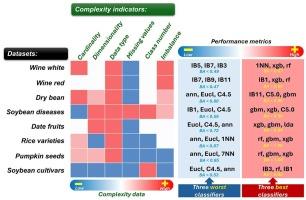Effect of agriculture-related dataset complexity on classical machine learning and deep learning classifiers performance
IF 8.9
1区 农林科学
Q1 AGRICULTURE, MULTIDISCIPLINARY
引用次数: 0
Abstract
This study evaluates how five indicators of dataset complexity affect the performance of 24 machine learning (ML) and deep learning (DL) classifiers across eight publicly available agriculture-related datasets. The indicators were cardinality (320–13,611 instances), dimensionality (7–35 features), class imbalance (Imbalance Ratio [IR] = 1–109.9), class number (2–40 classes), and feature types (numeric and ordinal). Performance measures, including sensitivity, specificity, balanced accuracy (BA), precision, F1-score, and Matthews Correlation Coefficient (MCC), were derived from confusion matrices generated via 10-fold cross-validation procedure. Macro and weighted-average were included as overall measures. Nonparametric tests (Friedman-Nemenyi; p < 0.05 and Cliff’s [δ]) were performed for weighted-average sensitivity and BA. Across 192 analyses, ensembles (GBM, XGBoost, RF) and C5.0 significantly outperformed other classifiers on 5 out of 8 datasets, achieving values greater than 0.91. Artificial Neural Networks (ANN) showed ineffectiveness for tabular data (BA ≤ 0.50). Extreme imbalance (White Wine: IR = 109.9) affected the classifiers performance, mainly for distance-based and probabilistic (MCC ≤ 0.34), even the ensembles partially mitigated the bias (BA ≤ 0.65). High dimensionality (Date Fruits: 34 features) favored LDA and RF (BA ≥ 0.93). Conversely, large multiclass (Soybean Cultivars: 40 classes) demonstrated higher performance of IBk (BA = 0.87). Sixty paired comparisons confirmed significant differences (p < 0.00001) and strong effects (δ = -0.57 to 0.18) between ensembles and underperforming classifiers, confirming that dimensionality, IR, and multiclass directly determine the performance. To the best of our knowledge, this is the first large-scale comparison of 24 ML/DL classifiers on eight agricultural datasets.

农业相关数据集复杂度对经典机器学习和深度学习分类器性能的影响
本研究评估了数据集复杂性的五个指标如何影响8个公开可用的农业相关数据集上24个机器学习(ML)和深度学习(DL)分类器的性能。指标包括基数(320 - 13611个实例)、维度(7-35个特征)、类失衡(失衡比[IR] = 1-109.9)、类数量(2-40个类别)和特征类型(数字和序数)。性能指标包括敏感性、特异性、平衡准确度(BA)、精密度、f1评分和马修斯相关系数(MCC),这些指标来自通过10倍交叉验证程序生成的混淆矩阵。宏观指标和加权平均指标作为总体指标。对加权平均灵敏度和BA进行非参数检验(Friedman-Nemenyi; p <; 0.05和Cliff 's [δ])。在192个分析中,集成(GBM, XGBoost, RF)和C5.0在8个数据集中的5个上显著优于其他分类器,达到大于0.91的值。人工神经网络(ANN)对表格数据无效(BA≤0.50)。极端不平衡(白葡萄酒:IR = 109.9)影响了分类器的性能,主要是基于距离和概率的(MCC≤0.34),即使是集成也部分减轻了偏差(BA≤0.65)。高维度(枣果:34个特征)倾向于LDA和RF (BA≥0.93)。相反,大型多品种(40个品种)的IBk表现较高(BA = 0.87)。60个成对比较证实了组合和表现不佳的分类器之间的显著差异(p < 0.00001)和强效应(δ = -0.57至0.18),证实了维度、IR和多类直接决定了分类器的表现。据我们所知,这是第一次在8个农业数据集上对24个ML/DL分类器进行大规模比较。
本文章由计算机程序翻译,如有差异,请以英文原文为准。
求助全文
约1分钟内获得全文
求助全文
来源期刊

Computers and Electronics in Agriculture
工程技术-计算机:跨学科应用
CiteScore
15.30
自引率
14.50%
发文量
800
审稿时长
62 days
期刊介绍:
Computers and Electronics in Agriculture provides international coverage of advancements in computer hardware, software, electronic instrumentation, and control systems applied to agricultural challenges. Encompassing agronomy, horticulture, forestry, aquaculture, and animal farming, the journal publishes original papers, reviews, and applications notes. It explores the use of computers and electronics in plant or animal agricultural production, covering topics like agricultural soils, water, pests, controlled environments, and waste. The scope extends to on-farm post-harvest operations and relevant technologies, including artificial intelligence, sensors, machine vision, robotics, networking, and simulation modeling. Its companion journal, Smart Agricultural Technology, continues the focus on smart applications in production agriculture.
 求助内容:
求助内容: 应助结果提醒方式:
应助结果提醒方式:


